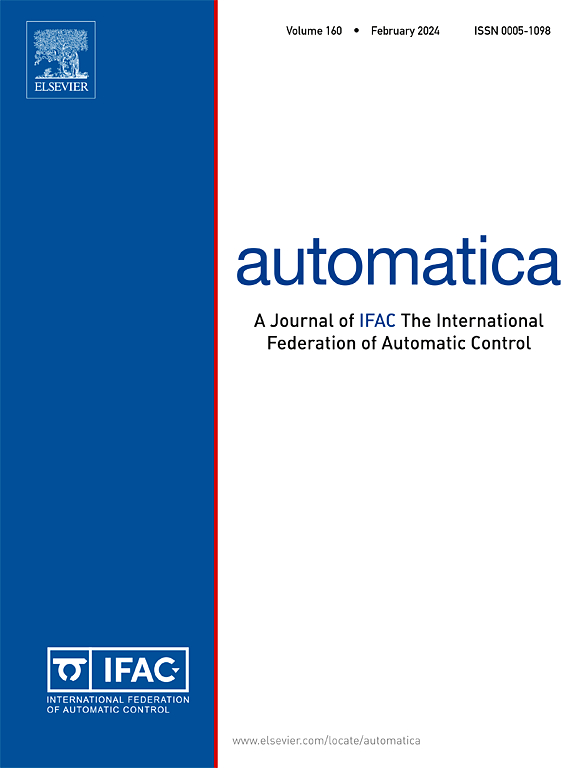动态参与者的分布式纳什均衡寻求
IF 5.9
2区 计算机科学
Q1 AUTOMATION & CONTROL SYSTEMS
引用次数: 0
摘要
本文提出了一个具有动态参与者的分布式纳什均衡寻求问题,其中参与者在决策过程中可以自由地加入和离开网络。为了适应玩家的动态加入和离开行为,引入了一种状态估计机制,能够在有限时间内估计玩家是活跃还是不活跃。基于状态估计机制,提出了一种基于梯度博弈的动态环境下分布式纳什均衡求解算法。结果表明,在强连接通信图下,每次玩家集合发生变化时,玩家的行为线性收敛于新纳什均衡的一个小邻域。此外,通过适当调整步长可以调整收敛精度和收敛速度。为了涵盖更一般的通信场景,将强连通图进一步放宽为b -联合连通图,在此基础上分析研究了所提算法的收敛性。此外,还量化了平均跟踪误差的上界来评价算法的动态性能。最后,通过对能耗博弈的仿真研究,验证了算法的有效性。本文章由计算机程序翻译,如有差异,请以英文原文为准。
Distributed Nash equilibrium seeking with a dynamic set of players
This paper formulates a new distributed Nash equilibrium seeking problem with a dynamic set of players in which players are allowed to join and leave the network in a free manner during the decision-making process. To accommodate the dynamic joining and leaving behaviors of the players, a status estimation mechanism, which is capable of estimating in a finite time whether the players are active or inactive, is introduced. Based on the status estimation mechanism, a gradient play based algorithm is developed for distributed Nash equilibrium seeking in the dynamic environment. It is shown that under strongly connected communication graphs, players’ actions are convergent to a small neighborhood of the new Nash equilibrium linearly every time the player set changes. Moreover, the convergence accuracy and convergence rate can be adjusted by suitably tuning the step-size. To cover more general communication scenarios, strongly connected graphs are further relaxed to be B-jointly connected graphs, under which the convergence properties of the proposed algorithm are analytically studied. Furthermore, the upper bound of the average tracking error is quantified to evaluate the dynamic performance of the proposed algorithm. In the last, a simulation study on energy consumption games is given to verify the effectiveness of the proposed algorithm.
求助全文
通过发布文献求助,成功后即可免费获取论文全文。
去求助
来源期刊

Automatica
工程技术-工程:电子与电气
CiteScore
10.70
自引率
7.80%
发文量
617
审稿时长
5 months
期刊介绍:
Automatica is a leading archival publication in the field of systems and control. The field encompasses today a broad set of areas and topics, and is thriving not only within itself but also in terms of its impact on other fields, such as communications, computers, biology, energy and economics. Since its inception in 1963, Automatica has kept abreast with the evolution of the field over the years, and has emerged as a leading publication driving the trends in the field.
After being founded in 1963, Automatica became a journal of the International Federation of Automatic Control (IFAC) in 1969. It features a characteristic blend of theoretical and applied papers of archival, lasting value, reporting cutting edge research results by authors across the globe. It features articles in distinct categories, including regular, brief and survey papers, technical communiqués, correspondence items, as well as reviews on published books of interest to the readership. It occasionally publishes special issues on emerging new topics or established mature topics of interest to a broad audience.
Automatica solicits original high-quality contributions in all the categories listed above, and in all areas of systems and control interpreted in a broad sense and evolving constantly. They may be submitted directly to a subject editor or to the Editor-in-Chief if not sure about the subject area. Editorial procedures in place assure careful, fair, and prompt handling of all submitted articles. Accepted papers appear in the journal in the shortest time feasible given production time constraints.
 求助内容:
求助内容: 应助结果提醒方式:
应助结果提醒方式:


